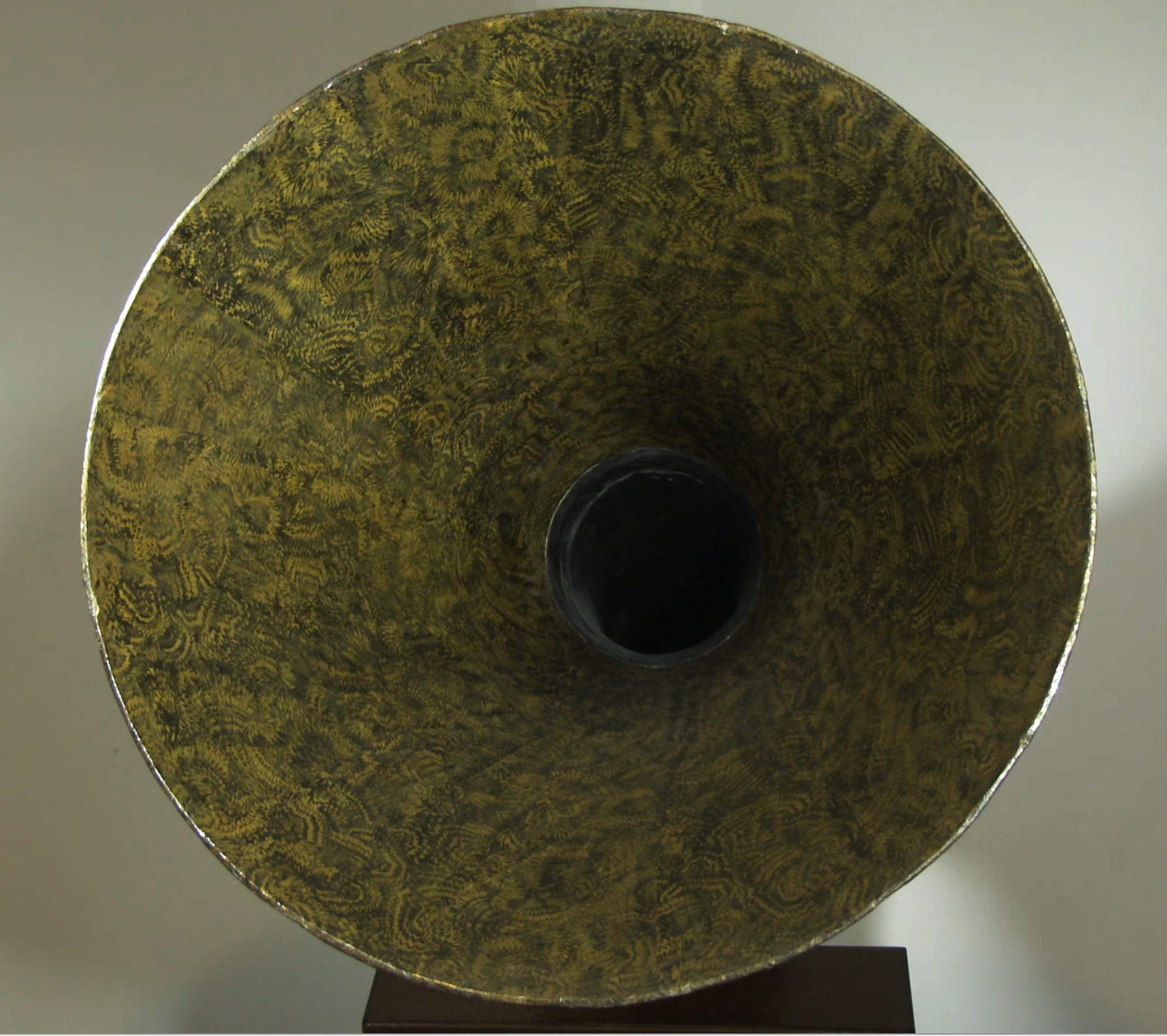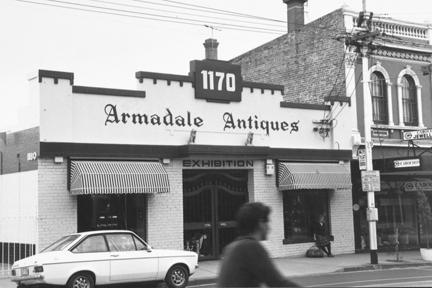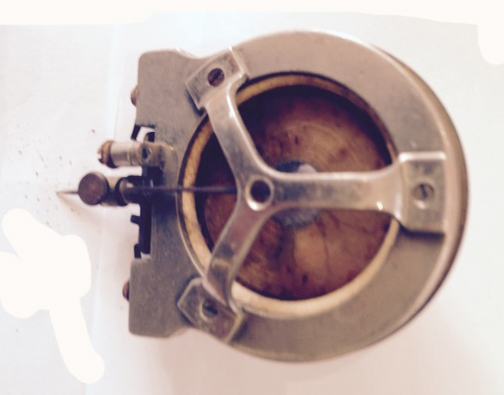« Contents | | Video demonstration of the Gramophone »
 |  |
Related information
- Conservation of the gramophone
- Video demonstration of the gramophone with John Amadio playing Mozart
- Other records played on the gramophone with different diagrams and needles
- Ancilliary equipment, documents and information
Introduction
Over 47 years, since my 21st birthday (1967), I have been privileged to be accompanied through my life by a monster antique gramophone. For a long time I knew it only as a present from my first serious girlfriend and preserved it both as a curiosity, for its rather aristocratic aesthetic and out of warm sentiment. More recently I have delved into its history and with the power of the internet, the marking of “Collaro D30” on its very heavy duty clockwork motor, and then the help of experts who I corresponded with, have identified it. It is indeed a most rare ‘find’, there being to my knowledge only three of this particular model known to have survived (there may of course be more), and it being a representative of what are widely regarded as one of the best (and one of the largest horned) mechanical gramophones ever produced.
The interesting history of “The E.M.G. Story” has been recounted by Francis James elsewhere.1 On page 71 of his well-informed account can be found a photograph of the E.M.G Mark Xb Export Model in all visual respects identical to the one in this collection (except that the measured maximum horn diameter is 28.8 inches which is closest to the canonical diameter of an Xa - typically 28 5/8 inches, rather than an Xb which would be 29.5 inches. Note however that as each gramophone was hand-made they could differ in these characteristics by some degree.).
The distinguishing feature of the Export Model is the bolted collar between the horn and the supporting horn tube.2 This innovation allowed this large machine to be dismantled for shipping, reducing the shipping cost by one half. And so it was that this machine was transported by ship to Australia, perhaps in the 1930s eventually ending up, so it is recounted, in a convent to provide dancing music for the girls. After that it reached a second hand store in time for it to become a present in October 1967.
Where was this gramophone before that? Did it go through other owners before it left for Australia? The only suggestive account that has so far surfaced is given by Francis James, of a Mark X which, “once the queen of the ballroom” of the Imperial Hotel at Torquay” (presumably in the UK), then travelled to Australia. According to James “it was retained by its [new] owner more for its dramatic appearance than for its voice, which was thin and muffled. After years of dissatisfaction with its performance, an examination was finally made to its tubes, and stuck firmly down the horn, out of sight was found - a teddy bear.”3 Careful inspection of the machine in this collection reveals no sign of the teddy bear (or even his paw prints), but with a new needle and good record the sound is both clear and loud to an astonishing degree. And in any case, Francis (“Frank”) James now informs us that the machine with that interesting history was an Xb.
Indeed, with its enormous horn, and mathematically designed components, the Mark Xa and later slightly bigger Mark Xb represented the pinnacle of the development of a mechanical gramophone for those purchasers who were willing to sacrifice all convenience of portability, and all considerations of use of space, to the most faithful sound quality and powerful rendition that could be obtained from the records and methodologies of the day.
As to provenance before it was given to me, time has eroded the full story. It was purchased from an antique store, long replaced by other buildings, which at that time on High Street, Malvern (just down from Glenferrie Road) and was probably the store then at 1170 High Street (see below). Allegedly, according to the then store salesman, the gramophone was used before that in a Melbourne convent playing music for the girls to dance to. And, as it must have been, it was said to have arrived in Australia in a ship.

The technicalities of the machine here contain the normal components:
- Horn bell maximum outer diameter 28.8 inches (by now slightly elliptical, 28.5 inches vertically, and 29.1 inches horizontally, circumference 90.5 inches) and allowing for a wall thickness of approximately 1.5 inches, inner diameter of 28.6 inches.
- Thinner horn tube “knuckle” (typical of the Mark Xa)
- Wilson Swan Neck tonearm
- 4 Spring Nickel plated brass soundbox
- Davey Isophonic 29” Bell horn
- Collaro D30 clockwork motor (this being the motor used in the earlier production of the machines - suggesting this may be a 1932 product.)
- Veneered mahogany plywood cabinet
with a price at the time of around 32 pounds sterling.4
A serial number “657” is punched into the board under the turntable platen.
There is however one oddity. The 4 Spring Nickel Plated Soundbox is equipped with a mica diaphragm (see below).
 |
The EMG Xa was introduced in November 1930. But it is probably not an early version given that this particular gramophone has a later ball bearing race at the base of its tonearm, lateral strengthening gussets on the lid to arrest any dangers of outward-bending (which I am reliably informed were experienced on earlier cases which had pegs to try to achieve a similar result) and the later single side hinges, as opposed to the single full width piano hinge that was supplied with earlier cabinets. Underneath the board supporting the gramophone turntable can be seen the conduit tube which leads from the tonearm to the tube opening into the horn. The one here is the “oversized conduit tube” - larger than that which was first used.5 So, it is likely that this Xa was not one of the earliest Xa’s produced. Further, its serial number of 657 suggests also a date more like 1932 or 1933.
By 1932 the E.M.G. company generally equipped their famous 4 spring soundbox (often considered the peak of achievement in this sort component) with an aluminium diaphragm. Aluminium was now entering much broader industrial use and could be tuned more precisely than the mica alternative. Yet this machine has a mica diaphragm, as well as being set up for the use of steel needles (rather than the usually preferred fibre needles). What then is the reason for this? It is possible, as one helpful expert has suggested,6 that this may have been a special order for a machine tuned to play the older acoustic (mechanically inscribed records) which since 1925 had begun to be replaced by electromagnetically inscribed counterparts. Perhaps the newer style of records had not been so quick to make it to Australia and the owner had a large library of the earlier style. Or perhaps there is some other explanation.
One other suggestion, by another expert who has pitched in, is that the original diaphragm could have been broken (which was apparently not hard to do if allowed to reach the end of a record which did not have effective run-off grooves). In that case, especially if this machine was by now in Australia, it may have been that a repair was only able to be practically achieved by harvesting the mica diaphragm and needle holder assembly from another soundbox and fitting it. Of course, this remains speculation. Close up photos of the soundbox can be viewed here If you know more, please contact the author.
For more on this gramophone, video and recordings, its conservation, and other details see:
- Conservation of the gramophone
- Video demonstration of the gramophone with John Amadio playing Mozart
- Other records played on the gramophone with different diagrams and needles
- Ancilliary equipment, documents and information
« Contents | | Video demonstration of the Gramophone »
1 Francis James, The E.M.G. Story, Old Bakehouse Publications, Gwent, 1998, ISBN 1 874538 27 1, (↑)
2 See here for an EMG 1934 catalogue, describing in its pages the Mark Xa and the export modification (for an additional cost of 1 pound sterling). (↑)
3 Ibid., p. 57 (↑)
4 ibid. p. 112 (↑)
5 Thanks to the expert advice that can be found at ongoing feedback from the community of experts who comprise The Talking Machine Forum and in particular from ‘Graham’. (↑)
6 see Chunny “the Gramophone Man”, creator of The Gramophone Museum (↑)
Pages linked to this page
 This work by Jim Falk is licensed under a Creative Commons Attribution-NonCommercial-NoDerivs 3.0 Unported License Click on the logo to the left to see the terms on which you can use it.
This work by Jim Falk is licensed under a Creative Commons Attribution-NonCommercial-NoDerivs 3.0 Unported License Click on the logo to the left to see the terms on which you can use it.